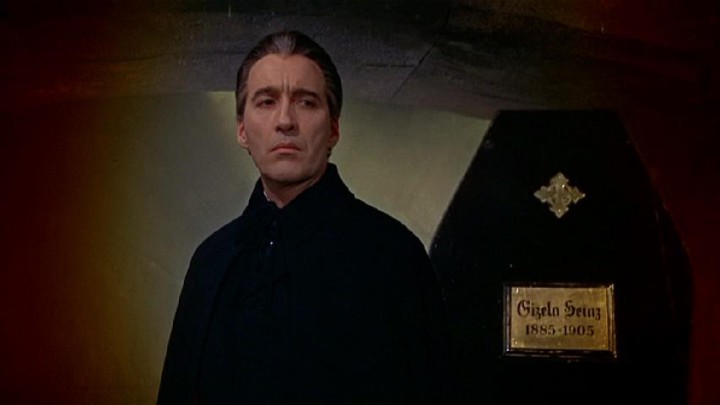Dracula Has Risen from the Grave will always hold a special spot in my filmic heart — for reasons only somewhat related to the film itself. On New Year’s Eve in 1969 the State Theater in Lake Wales, Florida showed — because nothing ushers in the new year like a Christopher Lee Dracula movie I guess — the film at midnight. Believe me, midnight shows were a novelty in Lake Wales. To the best of my knowledge this was only the second one — The Green Slime had been shown (sans special occasion) earlier that year — so there was no chance 15-year-old me was not going to be among the patrons. (Memory tells me that all 536 seats were filled, which may be a slight exaggeration.) I didn’t especially care for the movie at the time — I was a rather stuffy horror fan at that age and was skeptical of ones made after 1945 — but the experience was something else, especially at the very end. When the film got to its big climax — which seemed pretty gory at the time, despite the G rating (nobody really understood ratings yet anyway) — a young lady in the row in front of me promptly threw up. (Thank goodness she was in front of me.) Whether this had any bearing on why this second midnight movie was also the theater’s last midnight movie, I have no idea, but damn it was a memorable moviegoing moment.
These days I’m more kind to the film than I was in 1969. (I’d like to believe I’m less stuffy, but admirers of Italian zombie and cannibal movies — plus those who think The Blair Witch Project is actually good — might disagree.) There’s no denying that Dracula Has Risen from the Grave is what might be called Hammer basic. It’s just a reshuffling of elements from any number of other Hammer horrors — a simple plot, bumptious hero type, grumpy villagers, buxom beauties, a henchman, village idiot, ill-tempered Dracula, and assorted mayhem coated in not very persuasive blood. It’s also a little reactionary — probably in response to the Swinging 60s — since its hero (Barry Andrews) is a card-carrying atheist, who has to learn the error of his ways through his brush with the Prince of Darkness. (The film even cooks up a new piece of mythology for the purpose — the idea that staking a vampire only works if you pray over him afterwards.) Even so, the formula mostly works — in its way.
What makes the film work is its decidedly fairy tale ambience. The fact that a lot of the movie takes place with characters clambering around rooftops adds to this sense of unreality. Director Freddie Francis has also stylized everything to within an inch of its life. There’s scarcely a horror scene that doesn’t involve the use of rather too obvious color filter to goose the effect — and it seems that Francis never saw a wall he didn’t want to bathe in green, red, or purple light. Overkill? Oh, perhaps it is, but it gives the film such a naive charm that it’s hard to resist. And, yeah, for the time, it is pretty gory — no matter how tame it looks today.







I caught this and its predecessor on TCM two weeks ago. I forgot how much cheesy fun those Hammer films were. I have fond memories watching them as a youth on “Shock Theater” on Chattanooga TV . I know Dr. Shock and Dingbat will miss Me. Lee, as will I .